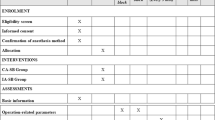Summary
A nerve stimulation-guided lumbar plexus block is a well-established technique. It is not clear whether ultrasound guidance has additional value for this deep block technique. This study aimed to examine whether ultrasound guidance using a paramedian transverse scan through the intertransverse space (PMTS-ITS) approach in combination with nerve stimulation reduces the onset time of a complete sensory block. Forty-four patients who were scheduled to undergo arthroscopic knee surgery with an ultrasound visibility score (UVS) of ≥10 for the lumbar plexus were enrolled and randomly allocated to the ultrasound guidance with nerve stimulation group (group U-N) or nerve stimulation group (group N) in this prospective, randomized, parallel-group, active-controlled study. The primary outcome was the onset time of a complete sensory block. The results showed that the onset time of a complete sensory block to pinprick and cold was 10 (10–40) min and 10 (10–40) min in group U-N, respectively, and 30 (10–40) min and 20 (10–40) min in group N (P=0.005, P=0.004), respectively. The performance time was 658±87 s in group U-N and 528±97 s in group N (P<0.001). There was no (0%) patient who required 5 or more needle passes in group U-N and 6 (27.3%) in group N (P=0.028). The block failure rate was 9.1% in group U-N and 31.8% in group N (P>0.05). In conclusion, ultrasound guidance using the PMTS-ITS approach in combination with nerve stimulation led to a faster onset of a complete sensory block than nerve stimulation alone for a lumbar plexus block in patients with a UVS ≥10. Ultrasound guidance with nerve stimulation significantly decreased the number of patients who required 5 or more needle passes.
Similar content being viewed by others
References
Marhofer P, Greher M, Kapral S. Ultrasound guidance in regional anaesthesia. Br J Anaesth, 2005,94(1):7–17
Liu SS. Evidence basis for ultrasound-guided block characteristics onset, quality, and duration. Reg Anesth Pain Med, 2016,41(2):205–220
Neal JM, Brull R, Chan VW, et al. The asra evidence-based medicine assessment of ultrasound-guided regional anesthesia and pain medicine: Executive summary. Reg Anesth Pain Med, 2010,35(2): S1–9
Neal JM. Ultrasound-guided regional anesthesia and patient safety: Update of an evidence-based analysis. Reg Anesth Pain Med, 2016,41(2):195–204
Awad IT, Duggan EM. Posterior lumbar plexus block: Anatomy, approaches, and techniques. Reg Anesth Pain Med, 2005,30(2):143–149
Kirchmair L, Entner T, Wissel J, et al. A study of the paravertebral anatomy for ultrasound-guided posterior lumbar plexus block. Anesth Analg, 2001,93(4): 477–481
Karmakar MK, Ho AM, Li X, et al. Ultrasound-guided lumbar plexus block through the acoustic window of the lumbar ultrasound trident. Br J Anaesth, 2008,100(4): 533–537
Karmakar MK, Li JW, Kwok WH, et al. Ultrasound-guided lumbar plexus block using a transverse scan through the lumbar intertransverse space: A prospective case series. Reg Anesth Pain Med, 2015,40(1): 75–81
Sauter AR UK, Bendtsen TF, Borglum J. The ‘shamrock method’ a new and promising technique for ultrasound-guided lumbar plexus block. Br J Anaesth, 2013 e-letter (http://www..bjaoxfordjournalsorg/forum/topic/brjana_el%3B9814)
Karmakar MK, Li JW, Kwok WH, et al. Sonoanatomy relevant for lumbar plexus block in volunteers correlated with cross-sectional anatomic and magnetic resonance images. Reg Anesth Pain Med, 2013,38(5): 391–397
Karmakar MK, Li X, Ho AM, et al. Real-time ultrasound-guided paramedian epidural access: Evaluation of a novel in-plane technique. Br J Anaesth, 2009,102(6): 845–854
Doi K, Sakura S, Hara K. A modified posterior approach to lumbar plexus block using a transverse ultrasound image and an approach from the lateral border of the transducer. Anaesth Intensive Care, 2010,38(1):213–214
Klein SM, Melton MS, Grill WM, et al. Peripheral nerve stimulation in regional anesthesia. Reg Anesth Pain Med, 2012,37(4): 383–392
Winnie AP RS, Durrani Z, Radonjic R. Plexus blocks for lower extremity surgery. Anesthesiol Rev, 1974,1(1):6
Marhofer P, Oismuller C, Faryniak B, et al. Three-in-one blocks with ropivacaine: Evaluation of sensory onset time and quality of sensory block. Anesth Analg, 2000,90(1): 125–128
Sites BD, Beach ML, Chinn CD, et al. A comparison of sensory and motor loss after a femoral nerve block conducted with ultrasound versus ultrasound and nerve stimulation. Reg Anesth Pain Med, 2009,34(5): 508–513
Bromage PR, Burfoot MF, Crowell DE, et al. Quality of epidural blockade. I. Influence of physical factors. Br J Anaesth, 1964,36(6):342–352
Lu R, Shen C, Yang C, et al. Comparison of lumbar plexus block using the short axis in-plane method at the plane of the transverse process and at the articular process: A randomized controlled trial. BMC Anesthesiol, 2018,18:17
De Andres J, Alonso-Inigo JM, Sala-Blanch X, et al. Nerve stimulation in regional anesthesia: Theory and practice. Best Pract Res Clin Anaesthesiol, 2005, 19(2):153–174
Farny J, Drolet P, Girard M. Anatomy of the posterior approach to the lumbar plexus block. Can J Anaesth, 1994,41(6):480–485
Sato M, Hara M, Uchida O. An antero-lateral approach to ultrasound-guided lumbar plexus block in supine position combined with quadratus lumborum block using single-needle insertion for pediatric hip surgery. Paediatr Anaesth, 2017,27(6):1064–1065
Liu Y, Ke X, Wu X, et al. Ultrasound-guided lumbar plexus block in supine position. Anesthesiology, 2018, 128(4):812
Author information
Authors and Affiliations
Corresponding authors
Additional information
Conflict of Interest Statement
The authors declare that there is no conflict of interest with any financial organization or corporation or individual that can inappropriately influence this work.
Rights and permissions
About this article
Cite this article
Xiao, Jy., Fang, Y., Yu, Y. et al. Ultrasound Guidance and Nerve Stimulation Combined Versus Nerve Stimulation alone for Lumbar Plexus Block: A Randomized Controlled Trial. CURR MED SCI 40, 1182–1190 (2020). https://doi.org/10.1007/s11596-020-2307-9
Received:
Accepted:
Published:
Issue Date:
DOI: https://doi.org/10.1007/s11596-020-2307-9




